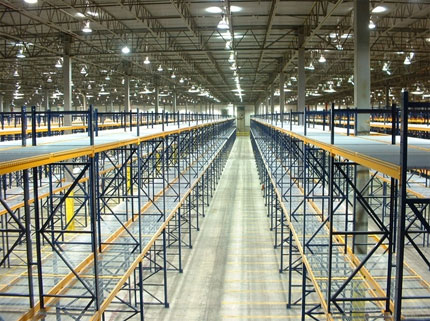Pallet Frames and Overall Capacities
How to deal with larger, bulky items in rack storage

Since overloading is a common source of pallet rack collapses, (in fact misapplication, including capacity issues, is the top cause) it’s important to understand how much weight your rack – not just your beams – can bear.

For a piece of storage equipment that is relatively simple, ensuring that the rack can hold what you want it to hold is sometimes complex – particularly on very heavy loads, or large but not so heavy loads. This article focuses on upright frame capacities. Beam capacities are pretty simple – they’re listed per pair of beams by most rack sellers, and you just adhere to them with your pallet loads. But frame capacity is not as straightforward as a beam capacity…
The first thing to understand is the issue of vertical load spacing. In general, a taller load will stress a rack as much as or more than a squat, heavy one. Fewer beams within a vertical space means less rigidity and a lower weight capacity for the upright. So if you have a 24′ frame and a very tall load that only allows 2 or 3 beam levels, frame capacity is diminished. Adding beams adds strength to the entire structure. Typically, any tall load (say, above 42″ high) requires additional work to ensure the rack structure can bear the weight. Rack frames, unlike beams, are rated per frame, not per pair.
For Steel King products, we have a page that illustrates the spacing differences for the same upright. This is the same with any rack you purchase – the more distance between beams, the lower the capacity.
In our online rack estimator, we frequently see situations where the estimator can’t return a result due to overly-tall loads. It is the most common reason that results aren’t returned. This is by design; when someone wants an estimate on a rack that is asked to do that, we want to get engineers involved in the design.
Capacities do not include the weight of the rack system itself. Deduct the weight of frames, beams, decking and accessories from your overall capacity. Typically these will be a relatively minor amount of weight in the scope of the rack load.
Column strength is comprised of 3 key elements:
- Decimal steel thickness (gauge),
- Yield thickness, and
- Sectional dimensions.
Steel gauge is actually a range of steel thickness, not a fixed number. Manufacturers refer to the gauge of their racking or shelving, and it’s a valid number, but it isn’t always the bottom line in terms of capacity. It is important (more steel tends to equal higher capacity, or at least more durability) but it isn’t the only factor.
Metal gauges are like golf: lower is better. Example: 14-gauge = .0677″ to .0817″, while 15-gauge = .0613″ to .0733″. And it’s not an exact science, either-steel gauges can vary by up to 18 percent. Capacity based upon a specific thickness dimension is generally managed by taking the lower end of the ratings, so manufacturers tend to understate the actual capacity of a piece of metal when gauge is a limiting factor.
Yield strength is a matter of metal quality. The better the steel, the higher the capacity, the better impact resistance and durability. Steel King, for instance, manufactures its SK2000 racks with 55,000 PSI steel. You’ll find a range of racks built with 50,000 PSI. Generally you do not have to worry about the yield strength of your racks, but the better racks are built with better steel.
 Sectional Thickness: A closed tube has a greater area than an open one, so it will generally bear more weight. Rack uprights made of closed tubing are inherently stronger than those with open backs. There is more steel involved, and it also helps racks made this way resist impacts better. Tubular posts have 44 times more torsional strength (resistance to twisting forces) than open back posts. Using closed tubing on columns, braces, and beams can result in a much stronger rack. (See drawing).
Sectional Thickness: A closed tube has a greater area than an open one, so it will generally bear more weight. Rack uprights made of closed tubing are inherently stronger than those with open backs. There is more steel involved, and it also helps racks made this way resist impacts better. Tubular posts have 44 times more torsional strength (resistance to twisting forces) than open back posts. Using closed tubing on columns, braces, and beams can result in a much stronger rack. (See drawing).
Uprights consist of columns and bracing. The bracing can also have an effect on the upright capacity. There are 3 primary types of upright frame bracing: C-shape sheet metal, C-shape sheet metal with return flanges, and closed tubular steel. The advantages of tubular columns also apply to bracing.

Tags: Material Handling, Pallet Rack, rack capacity, safe rack loading
Scott Stone is Cisco-Eagle's Vice President of Marketing with 35 years of experience in material handling, warehousing and industrial operations. His work is published in multiple industry journals an websites on a variety of warehousing topics. He writes about automation, warehousing, safety, manufacturing and other areas of concern for industrial operations and those who operate them.



